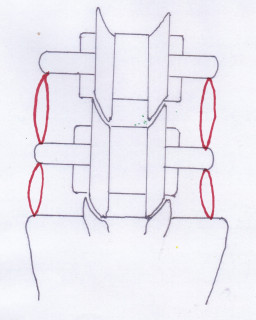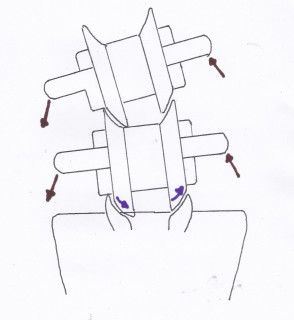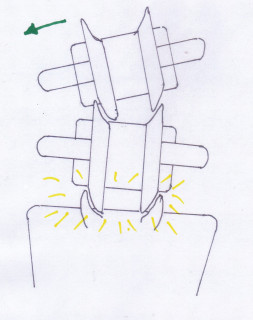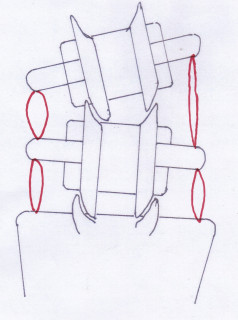Introduction
In this article we will briefly review some research findings in relation to the affects of vibration massage on allowing muscles to relax and lengthen, thus allowing joint range of motion (ROM) to increase. Following that we will discuss how we make a practical use of this. It is provided as general information only. While we hope you put it to great use, such use should be consistent with your training and your patient’s needs. Any feedback will be most appreciated.
Research on the effect of vibration massage on joint range of motion (ROM)
In all the trials below vibration massage was applied to muscles. Joint ranges of motion were measured, with increase being due to a lengthening of muscles allowing the joint to move further.
Trial One (1)
Knee extension was measured with the hip flexed to 90 degrees. Multiple applications of 50 Hz (cycles per second) massage were applied to the hamstring muscles over a eight week period. Compared with the control group the massage group had an average increase of 13-14 degrees.
Trial Two (2)
Hip flexion was measured by attempting to touch ones toes. For the massage group a 44 Hz massage was applied each day to the hamstrings for three days. A stretching group used conventional stretches each day, while a third group acted as a control. Both the stretching and massage groups showed a similar significant improvement in hip joint ROM
Trial Three (3)
This trial used the toe touching measurement and hamstring massage. Vibration massage was used with unspecified protocol on the hamstrings and erector spinae muscles. The massage group showed a 5cm improvement as compared to the controls.
Trial Four (4)
In this trial a straight leg raise (SLR) was measured. A proprietary device called “Deep Oscillation” was used. This is a device that has a pad that is applied to the skin. The makers claim that it’s therapeutic affect is from mechanical vibrations that penetrate. From what is understood the pad creates an electrostatic attraction to the skin that switches on and off. It works like having a vacuum cleaner on your skin switching on and off very fast creating a vibration. In other words, it’s an impressive looking, patentable and very expensive way to create a simple mechanical vibration. Anyway, the Deep Oscillation group had an increase in SLR over the controls.
Practical use of this information
Like stretching exercises, localised vibration massage has been shown to be an effective method of producing lengthening of muscles, and therefore increasing joint ROM. In some situations stretching exercises would be the best choice, while in others the use of vibration massage would be the best. This section will cover two situations where the use of vibration massage is by far the best choice, if not the only choice.
1. Situations involving damage or injury
2. Where it is difficult or impossible to isolate a stretch to a specific muscle or joint.
Additional benefits
As discussed elsewhere in our practitioner manual the use of vibration massage will have other beneficial affects. For example, if used as "stretching" during a warm up it will increase localised blood flow, help reduce post exercise blood flow and speed recovery. If used post exercise it will decrease soreness and speed recovery. As discussed in our section on assisting healing, if used as part of rehabilitation it will speed healing by increasing blood flow plus possibly a host of other affects.
Situations involving damage or injury
Injured ankle example
The first situation where vibration massage by far the best choice is where stretching can cause damage to an injury. Let us use an ankle sprain as an example. The typical treatment is to first immobilise the joint while the damage to the ligaments and other localised structures heal. While the joint is immobilised the calf muscles will shorten, but stretching at this stage would involve ankle joint movement which would damage the healing ligaments. On the other hand, as long as there were no contraindications localised vibration massage could be used on the calf muscles while the ligaments were healing. Once the ligaments heal far less rehabilitation would be needed.
Other examples
There are many other examples of where this principle could apply. It is very common for a person with an injured lower back to have muscles deep in around their pelvis and hips that are shortened and need stretching. However, stretches for these muscles also tend to put stress through the lower back, causing the risk of further injury. Vibration massage could be used on these muscles with the person lying in a neutral position. This should not place stress on the injured lower back.
Difficult or impossible to isolate a specific muscle or joint
Spine example
The second situation where the use of vibration massage is an excellent choice are functional problems where it is difficult or impossible to isolate a specific joint or muscle. Lets use the spine as an example. In your spine you have many joints, each doing basically the same thing. This spreads the work so each individual joint does not have to work to much. When a spine bends each joint should move a little bit, adding up to a complete movement. The issue here is that it is impossible to isolate movement or a stretch to one specific joint. It is a common situation for one joint to be injured then subsequently stiffen while healing. As this happens the adjacent joints often become hypermobile to compensate. In this situation how does one isolate movement to the stiffened joint in order to stretch that joint's intrinsic muscles? A spinal stretch will only isolate movement to a region of the spine, not to an individual joint. Within that region most movement would occur in the hypermobile joints. On the other hand vibration massage can be applied directly to the intrinsic muscles of the stiffened spinal joint.
References
(1) Bakhtiary AH1, Fatemi E, Khalili MA, Ghorbani R. Localised application of vibration improves passive knee extension in women with apparent reduced hamstring extensibility: a randomised trial. J Physiother. 2011;57(3):165-71
(2) J. Atha and D. W. Wheatley Joint mobility changes due to low frequency vibration and stretching exercise* Br J Sports Med. 1976 Mar; 10(1): 26–34.
(3) Beirman W. INfluence of Cycloid Vibration Massage on Trunk Flexion American Journal of Physical Medicine: December 1960 - Volume 39 - Issue 6 - ppg 219-224
(4) Hinman, M. R., Lundy, R., Perry, E., Robbins, K., & Viertel, L. (2013). Comparative effect of ultrasound and deep oscillation on the extensibility of hamstring muscles. Journal of Athletic Medicine, 1(1), 45-55.





